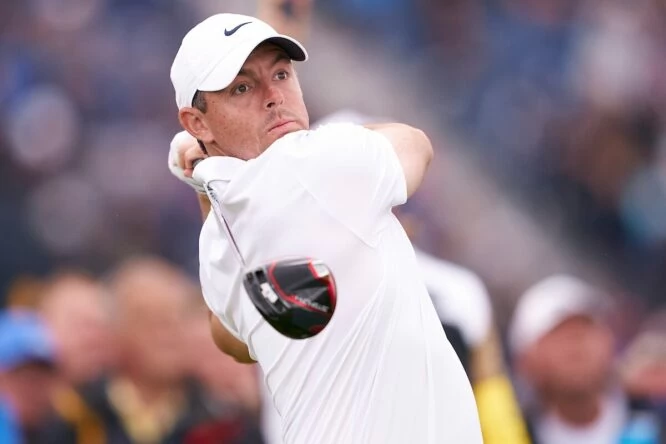The R&A and the USGA will update the test conditions used to conform golf balls from January 2028. The decision aims to reduce the impact that greater distance in golf has on the long-term sustainability of golf, while minimising the impact on recreational play.
The revised ball test conditions will be as follows: Clubhead speed 125 mph (equivalent to a ball speed of 183 mph); spin rate speed at 2220 rpm and launch angle of 11 degrees. The current conditions, which were set 20 years ago, are set at 120 mph (equivalent to a ball speed of 176 mph) and 2520 rpm with a launch angle of 10 degrees.
The revised conditions are based on the analysis of data from world tours and play over several years and aim to ensure that the average distance (whose limit will remain unchanged at 317 yards with a tolerance of 3 yards) continues to represent the ability of the game’s longest hitters. Tests at higher speed for the same distance. Conclusion: the ball must fly less to be conforming. An analysis of the ball speed among the longest hitters in golf in 2023 shows that the ten fastest players had an average ball speed of 186 mph, while the average ball speed of the 25 fastest was 183.4 mph (the fastest had an average of 190 mph).
The fastest players are expected to see a reduction in hitting distance between 13 and 15 yards. The average of professional and elite male players are expected to see a reduction of 9-11 yards, with a reduction of 5-7 yards for an average LET or LPGA player.
The change in test speed is expected to have a minimal impact on distance, 5 yards or less, for most recreational golfers. Research shows an average swing speed of 93 mph for male golfers and 72 mph for female players.
Balls approved in 2027 will be able to continue to be used by recreational golfers until January 2030 to give golfers, manufacturers and retailers more time to adapt. These decisions are in line with the commitments made by the governing bodies at the start of the project.
A significant portion of the golf ball models currently on the market – and more than 30 percent of all golf ball models submitted for conformity across the game – are expected to remain conforming after these changes are applied.
Martin Slumbers, CEO of The R&A, has stated: “We are convinced that this decision is one of the keys to achieving a sustainable future for golf, protecting the integrity of the game and fulfilling our environmental responsibilities. The measure we are taking has been carefully studied and calibrated, while maintaining the spirit of ‘one game’ that is considered so important to the golf industry. And most importantly, the impact on recreational golfers is minimal. We are acting now because we want to ensure that future generations can enjoy the unique challenge of golf as much as we do.”
“Governing is difficult. And while thousands of people will claim we did too much, there will be just as many who say we didn’t do enough to protect the game in the long term,” said Mike Whan, CEO of the USGA. “But from the beginning, we have strived to do what is right for the game, without prejudice. As we have said, doing nothing is not an option – and we would be failing in our responsibility to protect the future of the game if we did not take the appropriate steps now.”
The reports were drawn up following the joint conclusions of the governing bodies of the Distance Insights project: Implication of Hitting Distance in Golf, which shared the reasons why addressing the ongoing trend of increasing hitting distance and the consequent lengthening of the field is fundamental to the long-term sustainability of the game.
All golf ball and club manufacturers were informed of the decision on Tuesday and received full technical details and an implementation schedule. The extensive research and feedback received from manufacturers and other industry stakeholders throughout the six-year process and following multiple Areas of Interest and proposals from 2021 as part of the Equipment Regulation process are taken into account.
A copy of the letter and technical documents can be found at www.RandA.org/distance-insights.
The large amount of feedback received highlighted the global sentiment that maintaining a single set of playing rules and equipment standards is of vital importance to the sport and should be applied across the game. Feedback from manufacturers has resulted in the extension of the deadline to 2028 to allow more time for innovation and the production of new products for elite and recreational players.
In addition to the new ball test conditions, the governing bodies have agreed to:
Expand the focus of testing to better detect “Driver Creep”, which can result in drivers exceeding the limits set in the Equipment Rules. This is a change in the testing methodology for submitted drivers, in order to proactively identify and address driver models that are within current tolerance levels and have Characteristic Time (CT) values that are more likely to exceed the limit through regular use.
Continue monitoring drivers and explore possible additional options related to distance. Specifically, we will investigate the error tolerance of drivers and how they behave with off-centre impacts. This is an ongoing review and we will seek industry feedback and continue to work with it, including manufacturers, to identify driver design features that can be regulated as a means to reward shots in central impact position versus errant shots.
The R&A and the USGA are guided by the general principle of continuing to preserve the fundamental elements of golf: protecting the integrity of golf courses, including their total length and ensuring that a variety of skills are needed to succeed.
Longer golf courses require additional resources, such as water, the cost of renovating or moving elements such as tees or bunkers. The governing bodies believe that if this sport wants to enjoy a sustainable future in the long term, these economic and environmental impacts must be kept under control.
The Total Distance Standard was first introduced in 1976 and has been updated on three previous occasions (1980, 2002 and 2004). This is the first time that test speeds have been updated since 2004, when the current standard was set based on the longest hitters of the time.
Details of the study and full technical data from the Distance Insights project can be found at www.RandA.org/distance-insights.




